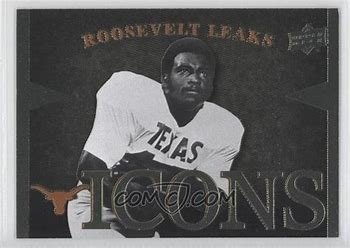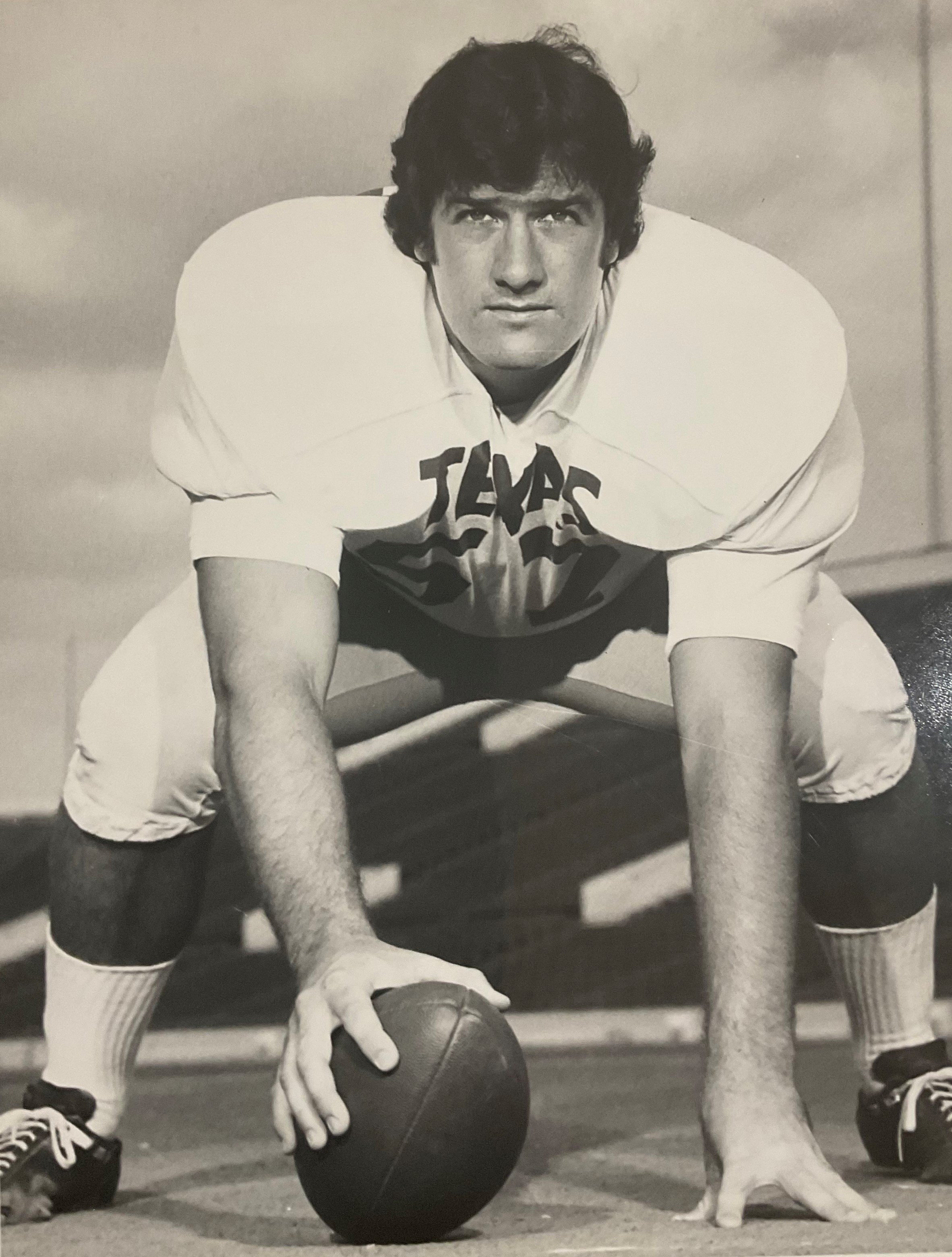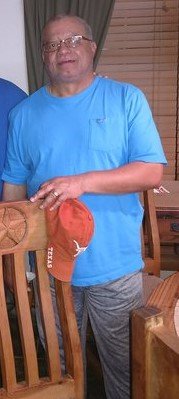Frank Medina and Spanky Stephens helping Rosey after his injury.
The University of Texas football program was awash with optimism when spring football drills began in 1974, fifty years ago. Springtime meant bluebonnets. It mean bronzing, bikinied bodies at Jester Beach. It meant the Longhorn baseball team – spearheaded by studs such as Keith Moreland, Richard Wortham and Jim Gideon – was on the prowl for another run at Omaha as it rolled through its final season at old Clark Field on campus.
On the radio, "Band On The Run" by Paul McCartney & Wings dominated airplay, and a former UT student, Steve Miller, had a huge hit song, "The Joker." Armadillo World was smoking, Posse East was hopping, and you could get a cheap meal, with a side of good-natured insults, at G/M Steakhouse on The Drag.
But on the minds of many on the Forty Acres was that the Longhorn football team was preparing hard for September. Texas would be gunning for its seventh straight SWC championship and Cotton Bowl. And UT's biggest gun was established as the early favorite to win the next Heisman Trophy. Stocky, sturdy Roosevelt Leaks, the bruising fullback with good speed, had starred in two sterling seasons with more than 1,000 yards rushing. The previous autumn, Leaks steamrolled to 1415 yards, averaging more than six yards per carry and racking up 14 touchdowns. A consensus All-American, he finished third in Heisman balloting behind two seniors, Penn State RB John Cappelletti and Ohio State OL John Hicks. The smart money for '74 would be on Leaks.
Veterans dominated Darrell Royal's team. Leaks would be churning and burning behind a talented band of linemen, including Bob Simmons, Bruce Hebert, and Bob Tresch, among others. Wishbone quarterbacking was in the good hands of Marty Akins and Mike Presley, and the defense would be headed by rugged tackle Doug English and LB Wade Johnston, the Cotton Bowl's defensive MVP.
But the '74 Longhorns' dreams and hopes got wrecked one fine spring day. Former UT center Bob Tresch looked back a half-century this week and recalled that Leaks had broken through the line and taken a hit low and from the side by DB Sammie Mason. "Nobody wanted to tackle Rosey head-on if they could avoid it," Tresch said.
Leaks was hurt. Hurt badly. Surgery would be a necessity.
Suddenly, a season – five months away -- was in the balance.
"It was a devastating blow to the team once we learned the severity of the injury," Tresch remembered.
Not surprisingly, UT spring football quickly took on a different tone.
"It was pretty grim," placekicker Billy "Sure" Schott said.
"Normally, there was a lot of cutting up in the locker room during spring. After that, it was just 'let's get through this.'"
Reminiscing about the fateful spring fifty years ago, Tresch said the injury would cost the team leadership and superlative talent.
"Everyone looked up to Rosey, and it wouldn't be the same without him."
Article written in 1998
Bob Tresch
The coaches and players knew that a star linebacker and running back from Tyler would be joining fall practice as a freshman capable of contributing. But counting on a guy who was still in high school right now seemed astonishingly iffy. Was this dude named Earl Campbell supposed to be Superman, or what?
In the crack of one tackle, he might now have to be.
"There was no way we expected Rosey to play that season," Tresch recollected.
Sports medicine had made many strides and even quantum leaps by 1974, from even the previous decade. But a serious knee injury to a running back? Most observers were hopeful that Leaks would redshirt and could return in '75.
The guy who wore number 46, the guy who had grown up helping his parents grow cotton and corn near Chappell Hill, who had led the Brenham Cubs to a state baseball title while starring in football, was on a first-name basis with work. Hard work.
Campbell, the slow-walking, slow-talking, drawling East Texan with cannons as thighs, got rave reviews in August practices. Come September he rambled for 85 yards in his college debut, as Texas roughed up Boston College in a 42-19 road win.
A week later in Austin, Texas drummed Wyoming, 34-7, and Roosevelt Leaks rushed for 56 yards and a TD on just seven carries. The most remarkable re-hab job on the books at Texas was in the books. Fans and sportswriters were astounded that the steamroller was back in business.
Teammates had seen Leaks reach down even deeper in a bottomless tank of will and resolve. Billy Schott took a break from raking oak leaves at his Bastrop County home this week to salute his former teammate and others instrumental in the comeback. "It's a testament to Rosey's work ethic, (legendary trainer Frank) Medina, modern medicine and (UT Strength & Conditioning guru)
Charlie Craven," Schott said, looking back at Leaks's commitment to return.
Was Leaks operating at full tilt? He was not. It wasn't physically possible. That does not diminish what he willed, not in the least. Rosey played hard as ever in a somewhat limited role that fall. He chalked up 409 yards on the season. Compare that to the 342 yards he amassed in one afternoon against SMU as a junior. Campbell led the Horns' '74 ground troops with 928 yards, setting the table for a monumental career at UT and with the Houston Oilers.
Campbell had a pretty special tutor in Leaks. "During practice, I was like a coach to him," Rosey told Kirk Bohls for the book, "Long Live The Longhorns."
I'd show him the little things. I wasn't quite ready to play again."
Leaks' NFL draft stock crashed because of the injury. Baltimore picked him in the fifth round. Other teams that passed on the stout-hearted Texan had to regret their lack of faith in his resurgence. The '73 consensus All-American and Southwest Conference Player of the Year adjusted to a new role as primarily a blocker. He excelled and played nine NFL seasons with the Colts and Buffalo Bills, a vital part of five playoff teams.
Still, a half-century after the unfortunate springtime knee injury that lives in infamy, it is hard not to "what if" about the possibilities stranded on the operating table.
"Had (the injury) not happened," Schott opines, "I think there would be a third name on that (Campbell-Williams) Field."
Meaning, simply, that he strongly believes Leaks would have preceded Earl as UT's first Heisman Trophy winner.
Bob Tresch, who helped serve up plenty of pancakes for Rosey at Texas, first as a tackle, then as UT's center, seemed to grow wistful when he wrote me an email regarding my questions about Longhorn football and the fateful spring of '74. First, he handed out plaudits.
"In my mind, Lonnie Bennett and Roosevelt Leaks did more than anyone to transform the University of Texas and help pave the way for black and white athletes," Bob wrote. "Earl was the icing on top." (Note: Bennett, a Longhorn running back from 1971-73, was the first African-American varsity player to score a touchdown for Texas.)
Then Tresch opened up a whole 'nother can of "I wish" worms.
"We can only wonder what a backfield with a healthy Roosevelt Leaks and Earl Campbell would have been like," he wrote, then apparently took a deep breath. "I'm finally over it."
I dunno know, Bob. Even fifty years down the ol' long, winding road, Longhorn Nation might have a hard time sleeping now, pondering that one-two punch potential. Damn. What might have been.
TLSN TLSN TLSN TLSN TLSN











